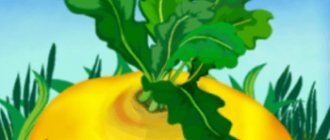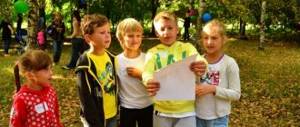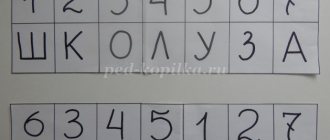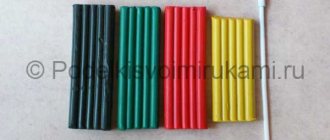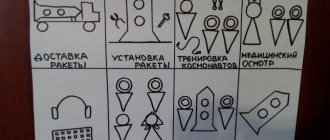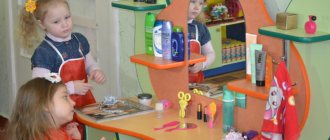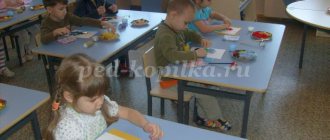Good day to you, readers of my blog, Tatyana Sukhikh is with you! Oddly enough, young educators ask me what attributes a group should have for the role-playing game Hospital. Naturally, bananas and oranges (just kidding!) I just want to ask: have you been to a doctor’s appointment, guys?
So, today I’ll tell you exactly what you can (need!) buy or make yourself so that children can have fun going to the clinic. As a bonus for beginning kindergarten teachers, I will list all the attributes for role-playing games for each age separately.
Online stores actively offer a lot of cool themed toys and attributes for various situational events at an affordable price. You can choose beautiful large sets or entire corners not only on medical topics, but also to imagine yourself as a seller, hairdresser, driver. If your kindergarten has reputable sponsors, purchase good quality material that meets the requirements of the Federal State Educational Standard for Education. At least you can buy a doctor's suitcase for the group. Today, the corners where homemade paper paraphernalia are laid out look rather sad. Comrades, we live in the 21st century!
But it’s time to return to the topic: attributes for the role-playing game “Hospital”.
By the way, I kindly ask experienced colleagues to critically check my list and add to it at their own discretion; I, as well as the “green” teachers, will be very grateful!
When planning to set up a themed corner, you need to remember that the older the children get, the more items they should be able to use while playing doctor.
So, the younger group: it will be enough to prepare a robe, a cap, a mask, a phonendoscope, a bandage, and a thermometer. These are the minimum items that kids will need. They are just learning the intricacies of the story game, so there is no need to overwhelm them with a lot of unknown concepts or subjects.
The attributes of the “Hospital” story game, the middle group, include, in addition to the named items, a nurse’s bag, a syringe, a heating pad, and a telephone. In addition to the doctor, there must be a nurse; the doctor can consult patients by telephone, and go out in an ambulance when called.
What attributes do older kids need for the “Hospital” corner? The list is extensive: in addition to the above, we add tweezers, a spatula, patient cards, medical scales, prescription forms, and x-rays. Attributes of oculists: tables to check vision, glasses (without glasses, of course). You also need to provide pharmacy items: medicine boxes, a cash register, a pharmacist’s scale to prepare medicine.
What is absolutely necessary for a children’s role-playing game “Hospital” in the preparatory group of a kindergarten? All of the above, and in addition, children already divide doctors into ophthalmologists, surgeons and therapists, so you need to prepare thematic tools. In addition, it is recommended to organize a game of laboratory tests - the nurse can take “blood” for analysis.
If you find all this and place it in the hospital corner, it will turn out to be the most correct and methodologically competent in the entire kindergarten!
It seems to me that the list of what is necessary for an effective game of “Hospital” is complete, but I would be extremely grateful to receive your comments, additions, and perhaps something needs to be removed from the list.
I am always glad to meet you again, my colleagues! Subscribe to news and share links on social networks!
Sincerely, Tatyana Sukhikh
Greetings to my readers and colleagues, Tatyana Sukhikh! Today we will talk about what attributes for a role-playing game you can make from paper and other available materials with your own hands, I’ll start with a lyrical digression. The fact is that my eldest son returned after serving in the army.
We sat at home, naturally, talked. He remembered how his kindergarten teacher played the game “Bunny’s Birthday.” There was a treat on the table and the guys started grabbing sweets and buns, but they turned out to be paper, not real. It was a laugh!
So many years have passed since that moment, but my son remembers with pleasure the funny event. What I mean by this is that, of course, there are wonderful factory-made toys and items on sale for any budget. But attributes for role-playing games made from paper or other material made together with children are no less interesting for kids.
It is my firm belief that preschoolers must be able to create using all kinds of materials! If a child knows how to handle scissors, glue and paper, he will be more successful in school - this is a well-known fact. Working with your fingers directly trains the brain, so you don’t need to buy everything for the group, let’s make role-playing game attributes from paper, foam rubber, cotton wool, napkins, etc.
By the way, in order to somehow interest and motivate our “computer” kids, you can use different stickers as encouragement. For example, there are special albums with lots of stickers for kids. The kids made cards and envelopes for playing mail, give them stickers instead of stamps. Or just reward them with cartoon stickers for diligence.
There are also special albums - they call it magic paper - very convenient for teaching children. There are pages with illustrations that need to be supplemented with appliqué. Although modern children are not so interested in making something with their own hands, we must, together with their parents, give them the opportunity to develop comprehensively.
For example, I do not hesitate to involve the mothers and fathers of my students in the process of updating benefits and attributes. How are things going with your parents? Do you entrust them with some creative work for the benefit of the family group? Tell us, everyone will be interested...
What can you do for role-playing games with your own hands?
I personally make simple attributes of a story game out of paper.
Cool idea for a space game: use salted dough to make a moon with craters, or other planets.
Take a small, round balloon. Knead the salted dough and coat the inflated ball with salted dough to represent the moon, spreading more somewhere, and somewhere pressing the holes with your fingers to represent a crater.
It turns out something like the moon.
You can also coat an inverted deep large plate, previously greased with vegetable oil, with salted dough.
Or make a poppie mache on a balloon. Thanks to the authors of the photos that I took from the Internet.
You can also use polyurethane foam, but this is the creativity of parents and educators; it is dangerous to give such things to children and that’s another story.
And toilet paper rolls are like space rockets.
They are very easy to make and don't require much imagination. Here is an interesting work by Larisa Smurova.
Empty juice boxes are being turned into great apartment buildings. We simply cover the boxes with colored paper, draw or glue windows and doors. To give the “houses” stability, pour sand or salt into the box.
What you need for the role-playing game “Police” made from paper is a traffic light and road signs. You can at least print the picture on a printer and then stick it on cardboard.
I really liked the idea I saw on the Internet - matchbox cakes.
We cover the boxes with white paper and then decorate them with paints, imitating the icing and decoration on the cake. If you carefully cut the boxes diagonally, paste them over and decorate them, you’ll get triangular pieces of a birthday cake.
What other attributes can be made from multi-colored paper? Doll furniture, a thermometer for the “hospital”... I saw with my own eyes a cardboard cash register with a pull-out tray containing “money”. Plus, it turns out that a paper washing machine can look like a real one!
Role-playing games “Shop”, “Cafe” will help children learn about the professions of a seller, waiter, and cook. "Country Yard" will give them an idea of a country house.
Contents of the article: It is no secret that children are much more interested in learning if this process is organized in the form of a game. The task of adults is to figure out what type of activity to offer the child and to provide the child with the necessary attributes. He will certainly enjoy interesting educational games, and this is for children in preparation for school. Both girls and boys can be involved, some of them will temporarily become cashiers, others will become sellers, and others will become buyers.
Role-playing game “Hospital (clinic)”
Unfortunately, a clinic or hospital is a place where we often visit with preschool children. Possible plots: Bear hurt his paw, Bunny’s ear hurts, we call the doctor home, Little Fox needs to be vaccinated, Mom has a sore throat.
Objectives of the game: developing interest in the medical profession, developing friendly communication skills, developing creative abilities and acting skills, developing speech, and selecting a few more items from my list.
Vocabulary: vaccination, phonendoscope, vitamins, etc. It is clear that for each age group the words correspond to the age.
Instrumentation: everything related to the hospital. I once told you how to make an ENT doctor’s mirror from a CD, and a thermometer from a wooden ice cream stick. But don't forget about substitute items!
I appeal to parents: do not think that using a stick instead of a toy thermometer is the lot of poor children for whom their parents cannot buy toys. The use of substitute objects is an important stage in the formation of imagination, fantasy, and ingenuity. Don’t immediately run to the store if you see how your baby has touchingly adapted caps from plastic bottles into cups and plates for dolls. Let him imagine that these are dishes!
Roles: parents, child, doctor, nurse, ambulance driver.
Preliminary work: as usual, poems, stories, visiting the medical office in the kindergarten, making attributes for the game.
Game actions: everything is like in life. We call a doctor by phone, the nurse applies a bandage, gives an injection, and gives a vaccination. The doctor listens to complaints and writes a prescription.
Role Play Store
You will find some attributes for it at home, others you can make together with the guys.
Of course, children will be happy to visit the confectionery department of the store. You will make the cakes for this game together with them. This way, children will develop fine motor skills, a sense of beauty, repeat colors, and practice counting. You can come up with a task for the child to write the name of the cakes. For this you will need:
- sponges;
- padding polyester or similar synthetic material;
- glue gun;
- roses made of satin ribbons;
- ladybugs, flowers for decoration.
- First of all, you need to apply the sponges to the sheet padding polyester. Have your child cut out synthetic white material using these outlines. Now you need to glue it to the sponge, as if it were frosting on a cake. you can do it in any way acceptable to you.
- These elements need to be glued to the top of the cakes, artificial sweets should be decorated with flowers, beads and other decorative items. If you don’t want to make flowers from fabric, then you can make or do things differently to decorate the cakes.
- Take a large sponge, cut a triangle from it, and glue black mesh material on top. You'll get a piece of cake. As with cakes, you need to make a price tag for it and put it next to this sweetness.
The role-playing game “Shop” is not only about creating similar assortment of products. To make everything for the game closer to reality, make products from the meat and fish department together with your child. To make boiled sausage, take:
- stocking;
- filler;
- strong rope;
- scissors.
Cut off the bottom part - the trace from the stocking, fill the resulting tube with filler.
This can be padding polyester, holofiber and even cut unnecessary things. Tie this blank with a rope, trim off the excess. To make a roach, draw a fish on cardboard and cut it out. The child will be happy to depict scales, eyes, tail, and other details on it. For fresh fish you will need:
- tray;
- pen;
- stationery knife;
- sheet;
- cling film;
- Styrofoam.
Have your child place the newly created cardboard fish onto the foam and trace it using this template.
But it’s better for parents to cut it out. If you use scissors, the foam may crumble, so it is better to take a stationery knife and use it for this job. Parents will do this.
Now the child will paint this blank himself. Help him put the fish in the tray and wrap this product in cling film.
The same film will be needed to make another product. Together with your child, you will create toy meat from corrugated cardboard. Let the child then paint it the desired color.
The rest of the food for the store will come from empty packaging. To do this, take a box of juice, dairy products, yogurt, wash them well, wipe dry. Glue the price tags here with your child.
It is best not to include cereals in the game if they are in the original packaging, since there is almost a kilogram there, and the grain can spill out, because it is covered with a thin film. Therefore, it is better to take small plastic bags and put some cereal in them. You also need to put price tags on them.
Of course, you can’t include real chicken eggs in the game, because they break. They are easy to make from foam plastic, giving it the desired shape. You can leave these items as is or put a white crocheted mesh on top of them. Also, for such a role-playing game you will need fruits and vegetables. You can use plastic ones or make them yourself. To make detergents, you need to tear the sticker off the real ones or cut them out of their packaging. Let the child take glue and attach labels to juice boxes, milk boxes, and plastic jars. To make the role-playing game Shop a success, look at how to make vegetables and fruits from various materials. These items will be durable. Children will play with them for a single day.
Remembering kindergarten
We sat at home, naturally, talked. He remembered how his kindergarten teacher played the game “Bunny’s Birthday.” There was a treat on the table and the guys started grabbing sweets and buns, but they turned out to be paper, not real. It was a laugh!
So many years have passed since that moment, but my son remembers with pleasure the funny event. What I mean by this is that, of course, there are wonderful factory-made toys and items on sale for any budget. But attributes for role-playing games made from paper or other material made together with children are no less interesting for kids.
It is my firm belief that preschoolers must be able to create using all kinds of materials! If a child knows how to handle scissors, glue and paper, he will be more successful in school - this is a well-known fact. Working with your fingers directly trains the brain, so you don’t need to buy everything for the group, let’s make role-playing game attributes from paper, foam rubber, cotton wool, napkins, etc.
By the way, in order to somehow interest and motivate our “computer” kids, you can use different stickers as encouragement. For example, there are albums, special albums with many . The kids made cards and envelopes for playing mail, give them stickers instead of stamps. Or just reward them with cartoon stickers for diligence.
There are also special albums - very convenient for activities with children. There are pages with illustrations that need to be supplemented with appliqué. Although modern children are not so interested in making something with their own hands, we must, together with their parents, give them the opportunity to develop comprehensively.
For example, I do not hesitate to involve the mothers and fathers of my students in the process of updating benefits and attributes. How are things going with your parents? Do you entrust them with some creative work for the benefit of the family group? Tell us, everyone will be interested...
How to make vegetables and fruits with your own hands?
The kids will be happy to make them from newspapers and paper. Tell them about the new papier-mâché technique if they are not already familiar with it. Before that, prepare:
- unnecessary newspapers and paper;
- PVA glue;
- semolina;
- paints;
- tassels;
- bowls.
Master Class:
- First you need to tear up the newspaper and sheets of paper. If you have real vegetables and fruits or plastic ones, then you need to lubricate them with PVC glue and attach paper pieces on top in several layers. If there is no such base, then use pieces of toilet paper or napkins, all this is put in a bowl, into which glue is poured, diluted in half with water.
- When the mass is well wet, it is taken out of the container, the excess glue is allowed to drain off, then fruits and vegetables are formed into the desired shape.
- Now children need to be patient, since all these blanks need to be placed on a tray and put in a warm place to dry. This will take 1–2 days.
- But after this time, they will take out their crafts and continue to create. If the papier-mâché mixture was applied to plastic or real fruit, then have parents carefully cut the top portion in half with a knife, remove the papier-mâché pieces from the base, and glue each pair into a single whole.
- Here's how to make vegetables and fruits that are formed from napkins and paper. Having taken these blanks in their hands, children will be able to immediately begin decorating. Let them apply glue to the surface. You need to put semolina in a separate container, the guys will sprinkle it on the sticky surface of vegetables and fruits made of paper.
- This layer also needs to be allowed to dry, only after this can you begin to paint these products in the desired color, using gouache and PVA glue, diluted in a one-to-one ratio.
Here's how to make your own fruits and vegetables to make them look authentic. Such games for children can be played at school or in kindergarten, in a senior, preparatory group. Children will be happy to do this kind of creativity at home.
Internet news from the world of educational and methodological literature
By the way, about the design of the card index. If you have money, but don’t want to bother with cards, you can easily buy ready-made sets based on themes, for example, in UchMag I found cut cards on the theme “Hospital”. Not to say that it’s just pennies, but once in your life you can buy materials and use them throughout your working life.
You can also find cards on the topic of family (a game for children 3-4 years old and older). It will also be convenient for parents to plan their play activities using cards... "UchMag" has also prepared a special educational CD with information on the topic: "Play space as an effective condition for the development of a child", the materials will be of interest to teachers and active parents who want to develop their child according to "the last word of science."
For moms and dads with an active position, I also recommend Natalya Krasnoshchekova’s excellent book “Plot-role-playing games for preschool children.” I believe that such a manual should definitely be not only in the home library, but also on the bedside table for constant study in free minutes.
Another good teaching method is “Plot-based role-playing games for the socialization of children 4-5 years old” from the “Growing up as citizens and patriots” series. Here we present, so to speak, in-depth materials on our topic.
By the way, I forgot to say that these two books can be bought at Labyrinth.ru - a good portal for people who read.
In general, the organization of direct educational activities (DED) in kindergarten is impossible without high-quality didactic materials, which are an indicator of the teacher’s professionalism. As the management says: it’s nice to look at a file cabinet or folders that are orderly, competent, neat, and solid.
Handmade products from thread and fabric
If parents know how to knit, they will create most of the products for a toy store or cafe from threads.
To make scrambled eggs with sausage, you will need: yellow, white, burgundy threads. Start knitting the fried egg from the center with yellow threads. Using a hook, create air loops, connect this chain to form a small circle. Next, you need to knit in the round. When the yolk of the desired size is created, change the thread to white and knit a circle with this yarn to the end. The sausage is made using the same technology, but from dark yarn. Circles of fats are embroidered with white thread.
To make spaghetti with ketchup, use:
- white yarn;
- hook;
- red fleece;
- filler.
Using a crochet hook, tie a long chain from white thread.
Even a 6-7 year old child can do this. Accustom children to needlework from a young age, teach them how to create simple objects like these. Cut out small circles from red fleece, fill them with filling, and sew the edges of the fabric on the back side. Place those drizzles of ketchup on the “pasta” and your game dish is ready.
With the help of such items, kids can imagine themselves in a cafe. Some will be waiters, others will be cooks, and others will be visitors. This way you will solve another problem, children will gain the skills to get acquainted with professions.
Look how wonderful these dumplings look, almost like real ones.
It’s not difficult to make them, the main thing is to take:
- white or yellow fleece;
- circle pattern;
- filler;
- threads with a needle;
- scissors.
Making master class:
- Place the circle on the wrong side of the fabric, trace it and cut it out. You will need several of these parts, as many as you want to make dumplings.
- Place the filling on one side of the circle, cover it with the other half. Using an over-the-edge seam, join the two halves of one dumpling. If desired, these preparations can easily become dumplings if you change their name.
- Other semi-finished products will turn into dumplings, you just need to pull their opposite corners to each other and sew them in this place.
Fish are easily created from fleece. To do this, you need to cut out 2 identical blanks from this material, fill them with synthetic padding, and sew them over the edge on your hands. All that remains is to sew on button eyes or glue store-bought ones. Although you can make them from a blister from a tablet, into which a small circle of plasticine is placed. The cakes can also be tied or made as described in the beginning. So, the children got acquainted with the profession of a seller, cashier, cook, waiter, learned to count better, express thoughts, and do needlework. Perhaps some of them will later want to become a farmer or start a farm; the following role-playing game will help with this. It will also give kids an idea about pets.
Role play country yard
Another goal of creating such crafts and games is to instill in children a love for their native land, so that they want to take care of birds and pets.
The children will improve their speech by coming up with short stories on this topic. To create such a craft, take:
- ice cream sticks;
- a box from a New Year's gift in the shape of a house;
- decorative stones;
- straw;
- scissors;
- toy pets;
- flat cardboard box;
- green paper.
Let the child coat the back of the sheets of paper with glue and attach them to the bottom and sides of the box.
The bench is easy to make. You will create a well from matches, gluing four in each row. Tie a thimble to a thread, and the bucket for the well is ready. To make a house, cover a cardboard Christmas gift with popsicle sticks.
If you do not have a similar base in the form of a gift house, then cut out the details of the structure from thick cardboard, connect them with slits and glue, and then decorate them with wooden sticks.
To make a barn for animals, you need to cover a base cut out of cardboard with straw. In this case, a blank for a bird feeder was used. Finally, make a fence out of popsicle sticks, a bridge, put some hay on the side of the composition, and place toy people and animals. By moving them, children will be able to act out interesting stories or make up a fairy tale. Tell them how to feed animals and care for them, the children will put this acquired knowledge into play.
Another rural courtyard can be made using cardboard as a basis. If the sheet is large, then simply roll it twice to make 3 walls. If the sheets are small, then first connect them together with tape, why cover them with colored paper.
Animal figures can be cut out from magazines and glued onto thick cardboard so that you can play with them and not wrinkle them. Children will be able to draw a house, trees, grass or cut it out of colored paper and stick it on a base.
These role-playing games will help children learn about various professions and agriculture. By engaging with them in a playful way, you will help your children prepare for school. Visual video tutorials also contribute to this.
The first one tells you how to make a papier-mâché apple. It will be useful for a toy store.
The following shows how to make scrambled eggs in a jam. This craft can also be used to play store or children's cafe.
Master Class
Target:
To help teachers in the production of attributes that have practical application for the creative development of children in role-playing games.
Tasks:
To cultivate in a person the ability to search, think, fantasize, and make independent decisions;
Organization of a master class
Master
: Dear colleagues!!! My name is Svetlana Arkadyevna Khromtsova. I am very glad to see you at my master class, the topic of which is: “Making attributes for the role-playing game Cosmos.”
(I suggest going to the tables)
Justification of the relevance of the topic
We all know that play occupies an important place in the life of a preschooler, being the predominant type of his independent activity.
Plot-role-playing games develop in preschoolers the ability to generalize, plan, and build their relationships with peers.
In play, the child develops, learns about the world, it is an effective means of shaping the personality of a preschooler, and develops the child’s independence and self-activity.
How to intensify children's play activities?
One of the main conditions is the creation of an appropriate subject-development environment.
The creation of an object-based play environment takes into account the age and individual characteristics of the preschooler. The attributes for role-playing games should be varied, colorful and aesthetic, since this is what the child will interact with.
Nowadays, you can buy a lot of toys in a store, but you must admit that if the toys are made with your own hands, and even children take part in this, they will acquire great value, since creating a play environment encourages children to be creative in their own games;
They will cherish such toys; And also, when making attributes for a particular game, children gain more knowledge.
That’s why, today at the master class, I would like to introduce you to
making attributes from scrap materials.
Practical activities of master class participants
“Making attributes for the role-playing game Cosmos”
Let's get to work. In a short period of time, you and I will have to make attributes for the plot-based role-playing game “Space”.
And for this, let's decide what attributes are necessary for the game?
Remote Control
Oxygen bottles
Headphones
Clothing for astronaut
Food
Binoculars…
You have the necessary material on your tables, but since there will be several attributes, let’s divide you and me into interest groups of who will do what.
I have prepared reminders for you that will help us in our work.
The other day I noticed that our girls began to treat dolls, hares and bears. They come to eat with their “patients” and sit them next to each other on a chair to observe how they feel at this time. They feed sick dolls with a spoon and carefully wrap them in toy blankets. Then they go to the room and carefully look after the sick. After watching these games, I decided that the little ones clearly lack doctor’s tools and other medical “bells and whistles.” To begin with, we purchased the “Doctor” toy set, and then... my mother’s imagination ran wild!
For three days my daughters watched my serious preparations, asked questions and clapped their hands. And finally, they were awarded the big doctor. It contains medical instruments, boxes with medicines, forms for writing down prescriptions, badges with their names and all sorts of interesting and useful things. In addition, the surrounding play space turned into a doctor's office for them.
When I conceived the “Doctor” playset, I really wanted it to come out:
- Interesting and exciting
so that you want to play with it again and again. - Informative
so that thanks to it the girls learn a little more about the profession of a doctor and the structure of the human body. - Educational
, so that the icons and inscriptions match and are large enough to read. And even though the girls can’t read yet, they know and recognize the letters. This way of presenting words stimulates reading, arouses interest in words and trains photographic memory. - Compact
because we don't have too much space to store it. - Durable.
This step is difficult to accomplish with paper, but possible :) To do this, you need to: print the set on thick landscape paper or whatman paper, glue the boxes and some other printouts onto cardboard, cover the finished boxes and some other printouts with tape.
And now the kit is ready and it seems to me that it fully meets all the listed points.
Now I’ll tell you in order what’s in the doctor’s box:
Medicines
Blisters, a regular medical syringe, an antipyretic syringe, a pipette (it was not included in the shot), a measuring spoon.
Paper boxes with medicines (ours are empty inside and taped on all sides for durability): vitamins, herbal tea, cold medicine, headache medicine, eye drops, heart medicine, ointment for feet.
Medicine bottles and jars (some empty, some containing buttons, glass beads and hama beads).
Materials for treating wounds and injuries
Plaster in skeins, plaster (printout), bandage, elastic bandage, dry wipes, wet wipes, a jar of cotton swabs, rubber gloves, protective masks, scissors.
Tools
A phonendoscope (an instrument for listening to the heart and lungs), 2 digital thermometers (plastic and printed), a hammer for a neurological examination, an otoscope (for examining the auricle), a bottle and a syringe (these are not instruments, of course, they just happened to fit into the frame :)
Medical documentation
A questionnaire for examining a patient (it is convenient to use it together with a writing tablet and transparent film, and write on top with a marker for a white board. With each new patient, the notes can be erased and written again: beautiful, convenient and saving paper), forms for prescriptions, cards with some human organs, doctor’s badge, cardiogram tape, x-ray images, medication instructions.
On the walls of the office
Signboard for the office door, posters with the human structure, posters for vision testing in children and adults.
What tasks do role-playing games serve?
- Active communication with peers and adults, learning the rules of communication, attentiveness to other participants in the process;
- Developing creative abilities through searching for interesting storylines in the game, coming up with non-standard solutions, selecting attributes;
- Training in self-organization through independent distribution of roles, resolution of conflicts and disputes;
- Developing a sense of tact and respect for comrades;
- Activation of mental activity, ability to analyze and plan one’s actions;
- Identification of various talents, interests, inclinations for expressive reading, acting, etc.;
- Arousing interest in the professions and activities of adults, respect for work;
- Nurturing positive human qualities: empathy, kindness, desire to help;
- Demonstrating a sense of humor and cultivating a friendly attitude towards others’ and one’s own mistakes;
- Increasing children's self-esteem by identifying their talents and abilities in front of the team;
- Fostering a sense of community and uniting children in a group;
- Formation of the ability to use substitute objects in order to develop imagination and non-standard thinking;
- Accustoming to the careful and careful use of toys and handouts;
- Teaching the basics of acting by conveying the character of the role according to the plot;
- Developing discipline skills and the ability to follow the rules of the game established jointly;
- Consolidating a strong interest in role-playing games as the most important way of understanding the world.
But let's return to the card index of role-playing games. Since on each card with the name of the game it is desirable to indicate the goals that the teacher sets for himself when offering children this or that fun, it is quite logical to use the above list of tasks and simply enter some of them, alternating them depending on the direction of the game.
